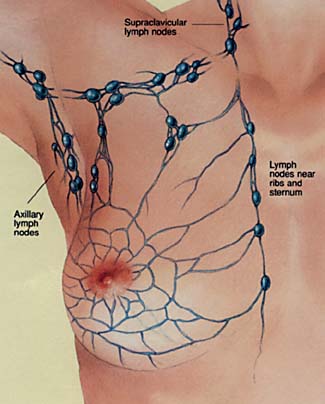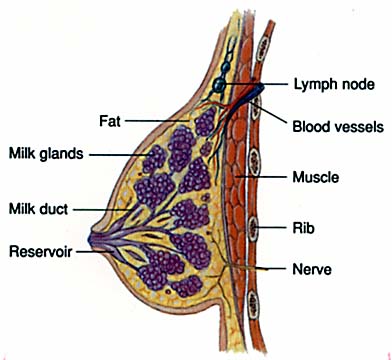
© 1994 Medical Doctors+Designers USA, Inc.
The lymphatic system serves as the sewage system for cellular waste in the body. The lymph vessels follow closely beside the blood vessels and receive the cells' waste products. This waste is carried by the lymphatics and is filtered through rounded areas of the lymph system referred to as the lymph nodes. Nodes appear as small round capsules and vary in size from several millimeters to several centimeters in diameter. Lymphocytes and monocytes are produced in the nodes and act as filters to stop bacteria, cellular waste and cancer cells to keep them from entering the blood stream. The lymph nodes may also serve as placed where cancer cells set up metastatic sites ( cancer that spreads from the original site to nodes).
Three percent of the lymphatic fluid draining the breast is found in the lymph nodes located in the area of the breast bone in the internal mammary nodes. Ninety seven percent of the fluid is drained through the nodes located in the area of the armpit, referred to as the axilla.
There are three levels of lymph nodes under the arm. The first level is located from the breast to the underarm area; the second level is behind the pectoralis minor, a small muscle on the chest wall. And the third level is located higher on the chest near the collar bone.
Axillary dissection, which is performed on the majority of patients with invasive carcinoma of the breast, refers to the removal of nodes from different levels of the axilla. The number of nodes vary from person to person.

© 1994 Medical Doctors+Designers USA, Inc.
Nodes are removed to determine whether cancer has moved from the breast into the node area. This can be of prognostic significance for the patient and will often direct further management. The term "negative" nodes means that the lymph nodes did not have any evidence of cancer. "Positive" nodes indicates that the cancer was found in the lymph nodes.
A relatively new procedure for evaluating lymph node status is "sentinel node mapping". The sentinel node procedure requires the injection of the breast tissue surrounding a cancer with a small amount of radioactive material just prior to surgery. With time, the radioactive material will migrate to the "sentinel lymph node". This lymph node is found in the operating room using a Geiger Counter. After the "sentinel lymph node" is identified and removed surgically, it is then evaluated by the pathologist. This node, the first draining node, is thought to reflect the status of the remainder of the lymph nodes in the axilla. If it is found to be negative, no further dissection is required.
